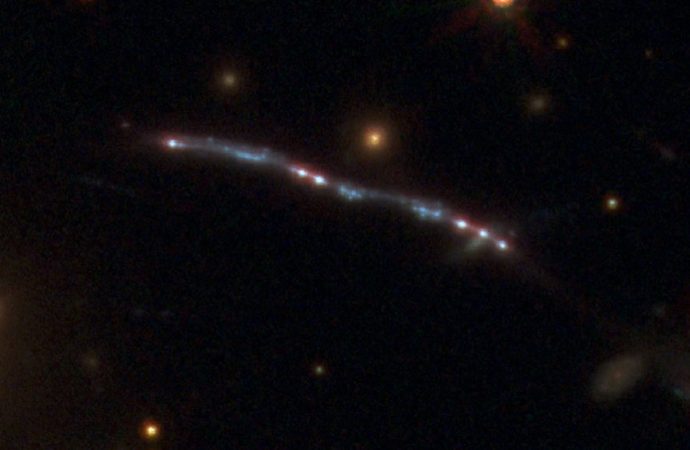Harsh ultraviolet radiation suggests how hydrogen got ionized in the universe long ago
Source: Science News
A leaky galaxy might be offering up clues about a vast cosmic makeover foisted on the universe during its youth.
Within about a billion years after the Big Bang, something stripped nearly all of the hydrogen atoms in the universe of their electrons. This “reionization” puzzles astronomers, who can’t account for all of the energy needed to make such a sweeping change.
A galaxy dubbed the Sunburst Arc might help. It appears to be blasting ionizing ultraviolet radiation through a small hole (or holes) carved out of the gas that permeates the galaxy, researchers report in the Nov. 8 Science. Similar channels in the earliest generation of galaxies could have provided an escape hatch for harsh light to zap intergalactic hydrogen.
While massive youthful stars can produce ionizing radiation, the light has trouble navigating the thickets of gas and dust within the host galaxy. “Not all of it can get outside the galaxy, let alone reionize the intergalactic medium,” says Brant Robertson, an astronomer at the University of California, Santa Cruz, who was not involved with the research. And yet, get out it must, given what happened to the cosmic inventory of hydrogen.
Directly looking for ionizing radiation from the first galaxies is out of the question. Intervening gas clouds absorb that faint light long before it reaches Earth. “The way to go about it is to look for [closer] analogs,” says Joanna Bridge, an astronomer at the University of Louisville in Kentucky also not a part of this study. “We look for galaxies that are similar … and gain an understanding of the physical processes that might have occurred.”

Meet the Sunburst Arc, a galaxy in the small southern constellation Apus whose light takes nearly 11 billion years to reach Earth — far, but not quite as far as the galaxies responsible for reionization. Part of what makes the Sunburst Arc special is that it hides behind a much closer cluster of galaxies. The gravity from that cluster amplifies and smears the Sunburst Arc’s light into an arc — hence its nickname — creating 12 distorted images of the galaxy smeared across the sky.
Without this gravitational assist, “we probably would not have noticed it,” says Thøger Emil Rivera-Thorsen, an astronomer at Stockholm University. “It would have been just one more speck out of millions.”
Two years ago, Rivera-Thorsen and colleagues noticed that a particular wavelength of ultraviolet light from this galaxy appeared to sneak out through small gaps in its hydrogen gas, like water through a sieve. This light is not energetic enough to ionize hydrogen. But through those gaps, the team hypothesized, more energetic ionizing light might slip out as well.
To test their idea, the team pointed the Hubble Space Telescope at the Sunburst Arc. In all 12 of the gravitationally distorted images, the researchers saw ultraviolet light capable of ionizing hydrogen blasting out of a small region within the galaxy. The source of the ultraviolet light coincides with a splotch of bright light seen in previous Hubble images, light that the team suspects radiates from a pocket of intense star formation no more than about 520 light-years across. The scientists think that the ionizing radiation from these young stars is using one or a few holes in the surrounding gas to escape into intergalactic space.
“This object is a unique lab for understanding the detailed way in which ionizing photons get out of a galaxy,” Robertson says. The find is also reminiscent of another much closer galaxy, where a few years ago astronomers reported a similar leak of ionizing light.
Whether this actually is a missing piece in the reionization puzzle remains to be seen. “In the part of the universe we studied, this is an atypical galaxy,” Rivera-Thorsen says. Out of hundreds of thousands the team has looked at, no other galaxy appears to behave this way. Whether such open pathways in the gas were more common in earlier galaxies is unknown. “That’s still an open question,” he says.
Source: Science News

































Leave a Comment
You must be logged in to post a comment.